Shifting to the Jungles [Author's Note: With the fall of Jaffna, the operations shifted to a protracted counter insurgency movement. It was a series of jungle bashing operations, small unit ambushes, raids, cordon and searches. While no public details exist on this operations and other's might be locked away in some regimental diaries, a general picture of the situation and the tactics and decisions of some of the players can obtained.] With the LTTE slipping into the jungles the overstretched IPKF began to build up for the long haul ahead. The 36th Infantry Division along with 2 additional brigades was brought in. It took over responsibility for the Trincomalee - Batticaloa and Vavuniya sectors while the 54th Division consolidated in Jaffna. Then in Feb 88 the 4th Mountain Division and 57 Infantry Division came in and took over Vanni and Batticaloa sectors from the 36th. The Jaffna sector was the smallest, about 60 km by 30 km) with a population of 200,000. About 16 to 20 battalions were employed in this sector. Then began the daily rituals of mine and IED explosions, unearthing of arms and shootouts with groups of LTTE men. The town of Jaffna was under the charge of Brigadier Manjit Singh. A tough and temperamental individual, he would lead some of his operations from a BMP. His impatience with his command led him to sack two of his COs, his Brigade Major and his Signal Officer. But his personal bravery and dynamism was beyond reproach and was later decorated with the MVC. He held Jaffna well although there was always tension in the town. When his Brigade was pulled off the task was passed on to Brigadier JS Dhillon. A man of few words Dhillon moved in quickly. He used his forces intelligently constantly thinking of changes. Small units scurried around the town in vans, cycles, mopeds and autos. They would scurry across backyards and over walls constantly changing their directions. Sometimes 3 to 4 columns would move in parallel in opposite directions, lashing out LTTE hideouts and also being able to provide covering fire. He made good use of the BMPs to keep the Eastern Coastal route clear. 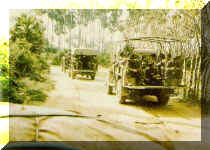 IPKF Troops in a makeshift tent at Palaly during the earlier days of fighting in Jaffna. 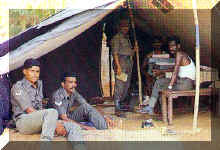 Vehicle mounted patrolling carried out by a Para battalion. The Vadarmachi town was held by Brigadier Samay Ram. He was a very calm man totally unperturbed. He was a hard thinker and was able to simulate the same in his subordinates. When his men were attacked from the Nallur Kandsawamy temple he refused to attack it back because of 30000 civilian refugees in the temple premises. The standoff was resolved when the LTTE keeping in mind civilian casualties choose to withdraw. A huge cache of arms and ammunition was found in the temple courtesy the son of the head priest an LTTE member. His excellent rapport with the locals, led to a lot of cooperation from the local heads. North of Jaffna extending into Kankesanthurai and Kayts island was the domain of Brig JK Ralli. Shrugging of the criticism of his units in the early battles he used innovative tactics and constantly evolving battle drills to keep the LTTE on its toes. He was the first to build an intelligence network from the ground up. A couple of units rehabilitated themselves into efficient outfits. In the jungles of the South, around the Killinochi farmlands, rimmed by the thick jungles of Vanni were the forces of Brigadier Jaspal Singh. The IPKF devised tactics to suit the terrain. In order to sustain operations for a longer time, without having to rely on air supplies, he established road axes for essential vehicles to penetrate the jungles for as far as possible. He planned artillery & mortar cover for all his vehicles ensuring immediate fire support. The Chetaks and Cheetahs were employed to guide artillery and Mi 25s towards the targets. Instead of indiscriminate jungle bashing, attacks were made on well identified targets. Wherever the opportunity arose for operations in flat farmlands BMPs were used aggressively. The area left of Pachchilaippali, the south eastern strip of land between Jaffna & Elephant Pass on the lagoon in the south were LTTE strongholds. 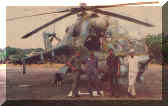 The Mi-24 was nicknamed 'The Crocodile' by the LTTE. Seen here at Palaly, an Infantry Officer, and a Tank Commander pose with the Helicopter Pilot. [Image ?? Newstime] 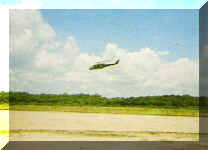 A Mi-24 'Crocodile' attacks an LTTE position at Mulai. As all the routes to Jaffna and Vadamarachi passed through this the IPKF tried to make inroads here. But the LTTE wisely preferred to keep low and bypass the IPKF rather than confront them. But soon under the charge of Brigadier Panag, a veteran of the Naga campaign things began to change. LTTE trails were picked up and ambushes set constantly. While the coasts were being hit, Panag kept the pressure on land with a series of deceptive mobile posts. In the lagoons a number of frail assault boats manned by Colonel Dahiya's engineers kept engaging the superior LTTE water borne forces. South across the Killinochi belt in Mulaivithu was the largest concentration of LTTE camps and cadres. In charge of this area was Brigadier Palsokar. His men were involved in the maximum number of battles. Major action was observed in Alampil (May 88), Nittukaikulam (Sept 88) and Nayuru April May 89. These places were interconnected and heavily defended indicating the presence of the LTTE leadership. Jungle Bashing: Operation Trishul and Viraat About this time, the IPKF's doctrine of counter-insurgency against the LTTE was evolved. The answer was not to maintain strongholds in the Jaffna peninsula, but to actively conduct search and destroy missions against LTTE camps and bases in the dense tropical forests of the North. This 'Jungle Bashing' would involve aggressive patrolling by the individual infantry units . This also resulted in the casualties mounting steadily. but the professional pride and esteem of the Indian Army served to steel its morale. The first phase of IPKF operations in the area was codenamed Trishul and Viraat. It spread out over the Northern provinces from Mannar to Mullaitivu and Elephant Pass to Vavuniya. As the heat turned up the LTTE started operating more from the Nittaikulam areas close to the lagoons and rivulets it new so well. This was where its supplies continued to be delivered. The LTTE was hit hard losing area commanders and leaders every day. In one instance an IPKF assault in Mullaitivu in Feb 88 almost trapped the IPKF's top leadership. A gallant rearguard action by Prabhakaran's guards ensured his escape.12 LTTE men were found dead after the fight. 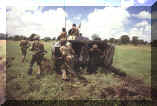 Troops of a Mechanised Infantry Battalion disembarking for an action during Operation Pawan. Operation Trishul was launched in April 1988. Its result were modest, hundreds of weapons seized and few killed but it kept the pressure up. Operation Viraat was launched in May/June 1988. A force of 15,000 armoured personnel, infantrymen and paratroopers were used. During the operation the IPKF stumbled across well prepared defenses. It consisted of concrete bunkers with electric generators. A few guerillas were captured or killed but most melted away. But sometimes, the LTTE struck back. When they did do so, it was at the time and place of their own choosing. So vulnerable convoys and lone vehicles became the targets for ambushes. The LTTE were masters at the use of landmines and improvised explosive devices. For a while, these IED attacks were neutralised by the cutting off power to the Jaffna Peninsula. but it was not a permanent solution. Thus the Army suffered a number of causalities to these ambushes. Ambushes by gunfire were rare, and when carried out by the LTTE, they found that the army bounced back with great fervour. The army rose to the occasion in these small actions. Young officers and soldiers displayed extraordinary courage and bravery in the face of death. Of particular mention would be two soldiers of 1/11 Gorkha Rifles. 1/11GR was one of the original battalions that was inducted for the fighting in Operation Pawan. After the Capture of Jaffna, its mission was primarily sending patrols on 'Search & Destroy' missions. One Patrol on such a mission on 16 March 1988 in the Vallankulam Pannai area ran into an ambush when enfilade gunfire rained down on them from the dense jungle growths. The Gorkhas hit the ground and returned fire. Slowly they organised themselves and extricated themselves out of the site. In the Melee, two Jawans got separated from the main column, Havildar Devinder Singh Gurung and Rifleman Rajender Bahadur Thapa were both pinned down by heavy fire. By the time they could extricate themselves, the main column has disappeared, as both were presumed to be missing in action. As both the jawans were making their way through the undergrowth, they came under fire from LTTE Snipers. In the exchange of fire, Havildar Gurung was hit in the thigh and was not able to move. Rifleman Thapa then picked up Havildar Gurung and carried him on his shoulders to a hut nearby, returning the odd burst that came his way with fire from his Ishapore rifle. Once in the hut, Rifleman Thapa administered first aid to Havildar Gurung and surveyed the situation around him. The LTTE had identified the two soldiers hideout and slowly have started encircling the Hut from a distance. Even as the LTTE Militants slowly made their way to the hut, Rifleman Thapa picked them off with single shots from his Ishapore. His main concern was to save ammunition, and use it efficiently. Resisting the temptation to waste the ammunition in general direction of the militants, Rifleman Thapa used it only when he could clearly identify his target. The exchange of fire went on and on well into the next day. Early morning on March 17th, a patrol sent by 1/11GR in search of the two missing soldiers was drawn to the hut by the sound of gunfire. The LTTE Militants decided to call it a day on the sight of the approaching patrol and fled. Rifleman Thapa and Havildar Gurung were thus recovered safely. Rifleman Thapa kept a cool mind and as a result he was able to keep the LTTE Militants at bay for more than 17 Hours. During the time, he fired only 22 rounds, and was well a target for hundreds of rounds fired by the AK-47 Rifles of the LTTE. Two dead militants were recovered as well as another wounded LTTE man. It wasn't always the Jawan or the NCO that displayed such bravery and courage, young officers barely out of the Indian Military Academy (IMA) thrust into the sweltering Jungles of Jaffna too showed that they could give a fitting reply to the LTTE. 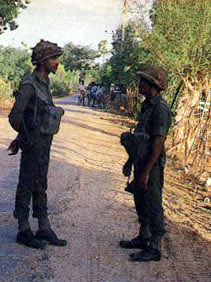 The early days at Jaffna, troops at a check post. [Image ?? Frontline] On 19 July 1988, a convoy of a two vehicles of the 7th Battalion of the Assam Regiment was making its way from Madurengkenikulam to Mangani to collect dry rations. In charge of the detail was a young subaltern, 2nd Lt. Rajeev Sandhu, who was barely six months out of the IMA. 2nd Lt. Sandhu was traveling in the Mahindra Jeep, leading the way to the 1 Ton Nissan truck which was trailing 50 meters behind the jeep. Driving the jeep was Sepoy NKKS Rajkumar, 2nd Lt. Sandhu was in the next seat. Sitting in the rear was L/Nk Nandeshwar Das and Sepoy Lalbuanga. As the vehicles reached a track junction, a rocket fired from the undergrowth hit the jeep, lifting it into the air and overturning it to the side. Immediately a fusillade of fire from the AK-47s straddled the overturned Jeep. When the volley of fire ended, and silence descended on the ambush site, the LTTE militants knew that this was one convoy that never made it to the Army base. They came out of their ambush positions to pick up the weapons and equipment of the fallen soldiers. 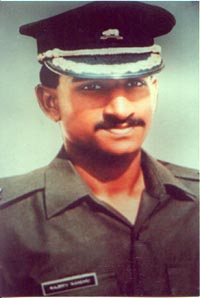 Second Lieutenant Rajeev Sandhu earned the Assam Regiment its first Maha Vir Chakra during the Operations in 1988. But one Indian Soldier still had his wits around with him. Out of the view of the militants, 2nd Lt. Sandhu, was dragging himself with his 9mm SMC Carbine out of the wreck. Both his legs were smashed when the rocket hit the jeep, the subsequent volley of fire had wounded him and he was bleeding profusely. He checked the other occupants of the jeep. None of them were conscious. In fact the initial blast of the rocket was borne by 2nd Lt. Sandhu. The machine gun fire that followed killed both Lance Naik Das and Sep Lalbuanga in the rear. Driver Rajkumar was wounded and unconscious. Sandhu tumbled out of the Jeep and crawled to a fire position. As one of the LTTE militants by the name of Kumaran approached the Jeep. Despite his legs being totally smashed and his body ridden with bullets, 2nd Lt. Sandhu lifted his carbine with blood soaked hands and sprayed Kumaran with bullets, killing him instantly. However, the bleeding had already taken its toll. 2nd Lt. Sandhu succumbed to his wounds and injuries. A grateful nation recognised his bravery with the award of a Maha Vir Chakra in 1990. 2nd Lt. Sandhu was just 22 years old when he died in Sri Lanka. Incidents like these were what kept the LTTE from underestimating the fighting prowess of the Army. They knew that they could not compare the fighting calibre of the Indian Soldier to that of the Sri Lankan Army. The Indian Soldier was coming from a background of operational exposure in areas like the Jungles of North east and the Mountains of the North. Death and Hardship were not a stranger to him, thus He was more ready and more experienced in fighting back to the hit and run tactics of the LTTE. 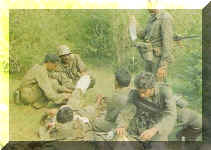 A soldier injured in a mine explosion gets first aid on the frontline. As a prelude to the elections to the newly created North Eastern provincial council the IPKF launched Operation Checkmate. Operation Checkmate did bring some results, inflicting causalities on the LTTE. On one occasion, the IPKF almost caught the top LTTE Leadership consisting of Prabhakaran, Mahataya and others. But in the fluid situation, the LTTE leaders managed to slip out. Many camps and carefully sited positions of the LTTE were rooted out and destroyed. These measures ensured that the LTTE was in no position to disrupt the coming elections. The Jungle Bashing soon came to a halt, as the IPKF concentrated on the upcoming Provincial Council elections. Operation Checkmate ended by the middle of October 1988. |